Nepal October 8 – November 17, 2012.
My first mistake was flying into New Delhi when I needed to be in Kathmandu one week later. The second mistake was applying for a multiple entry visa for India as I wanted to visit several other countries from India. This type of visa is difficult to obtain in Canada. After 2 weeks, the visa had been changed to a triple entry, my flight itinerary and travel plans for the entire 7 month holiday {all conjecture} had been submitted, and the visa was sent to the Indian consulate for approval. As I was now 8 days from my flight, I emailed 4 times to make sure the passport was not mailed but kept for pickup in Vancouver. It was mailed on a Friday with delivery to be on Tuesday, the day I was to fly. I canceled my points flight and bought a new flight to Kathmandu.
On Sunday, I caught the Greyhound to Vancouver, made the obligatory trip to MEC, and spent a lovely evening with my daughter. On the Canada Line at 10 PM, my flight left for Hong Kong at 2:45 AM. Sitting next to me was a pleasant fellow from Edmonton and we had the same flight to Kathmandu. It was good having company for the 12-hour layover in the spacious Hong Kong airport (I didn’t realize that we could have gone into Hong Kong to sight-see). We eventually took off and after a brief stop in Dhaka, Bangladesh, I arrived in Kathmandu at 10:30 PM with arrangements to be picked up by my hotel. The Nepal visa requires a passport photo, $100, and 15 minutes. Driving on the left through multiple, dark, twisty back streets, was disorienting. My nice private room had views down to a shrine and a huge sacred tree.
KATHMANDU
People started visiting the Hindu shrine and ringing the bells at the base of the tree at 5. The plan for the day was to take one of the Lonely Planet’s Walking Tours – South from Thamel to Durbar Square. With no street signs or numbers on buildings, navigating the city of 1 million requires all one’s abilities. The closest thing to an address for my hotel was Thamel, a large area with at least a dozen roads and several hundred hotels and restaurants. Apparently, most mail makes it to its destination. Pedestrians compete with motorcycles, cars, and bicycle rickshaws for the narrow side walk-less streets. Stores selling trekking equipment and everything else occupy the street level of the 4-5 story buildings. There are no empty spaces and amazingly everybody seems to make a living. The fast-paced succession of sights, odours, colours, and sounds in the maze of streets makes these walking tours a highlight.

Finding all the hidden temples, shrines, courtyards and interesting architecture gave a real sense of self-satisfaction and was a lot of fun. Often the directions consisted of finding signs like “Opera Eye Wear” and “Janishes Beauty Parlor”. Everyone speaks English and was more than helpful with directions.
Kathmandu must be one of the few capital cities of the world with no addresses, street lights, and subject to daily rolling blackouts.
Durbar Square. Durbar means ‘palace’ and this is where the kings were crowned and where they lived. Consisting of three loosely connected squares, the area contains at least 24 temples, 10 courtyards, multiple shrines, statues, a great bell, and a large palace complex.
It even has its own living goddess, a handpicked girl who becomes mortal at puberty. She was on strike around 2005 over a dispute about sharing proceeds from the square admission ticket but now appears at her window for tourists. After the exhausting day and a big dose of sensory overload, I managed with only a few wrong turns to find the Holy Temple Tree Hotel and a welcome bed.
Besides being constantly badgered to buy jewelry, flutes or miniature chess sets, one has to deal with the many touts wanting to take you on guided trips. After losing the elderly guy three times, I finally relented and he met me at my hotel the next morning to take me to Boudhanath, a huge Buddhist Stupa about 7kms from the city centre. There are four World Heritage Sites in Nepal – two are natural [Chitwan and Sagarmatha [Mt Everest] National Parks] and two are cultural [Lumbini, the birthplace of Buddha, and the seven monuments in the Kathmandu Valley which together count as one site]. The seven sites are the Durbar Squares in Kathmandu, Patan and Bhaktapur, two Hindu temples and two Buddhist stupas.
Boudhanath is surrounded by hills in the centre of a natural mandala, a store of sacred energy. It is one of the most important Buddhist pilgrimage sites in Asia. Its origins go back before folk memory and it has been rebuilt many times. The stupa’s main dome is 120 feet in diameter and 43m high. The huge whitewashed stupa is crowned with a four-sided all-seeing eye, and a great gold tower. Prayer flags stream off everything. We went into two of the 30 plus monasteries each with their own gigantic Buddha and listened to a group of monks chanting and playing horns and drums.
We then walked SW towards town to Pahuptinath, a Hindu temple celebrating Shiva, the God of Gods. After climbing many steps, walking by many tombs and Sadhus (Hindu Holy Men, who try to look as bizarre as possible to pose for pictures for money), we arrived at the Bagmati River and its cremation ghats. It was fascinating to watch the preparation of the body and wood pyre. Hindu temples are not accessible to non-Hindus and we only got looks from across the river.
The front veneer on my left upper incisor fractured off and I made a visit to the People’s Dental College. I was immediately seen by an intern who had just finished 5 1/2 years of dental training. With 5 empty dental chairs and 8 other interns chatting and looking at dental texts, she did a thorough history and exam. Her job finished, I was taken up to the specialist clinic. A young resident repeated the above and called the chief resident who called the professor and 8 other residents. He pronounced the diagnosis and treatment, and a prolonged discussion ensued mostly about the need to deal with it before leaving for my trek in 3 days. Impressions were made and I was to return on Monday at 11. The fitting was checked, the veneer polished and I returned at 2 for final cementing. They did a perfect job and all that attention for about $90. They must have taken 50 pictures of the whole process for their teaching files.
I changed hotels to the Fuji where I was to join up with Tom Carter of Moon Mountain Adventures, our guide from one of the Gulf Islands, and the four other trekkers from BC. We had 4 days in Kathmandu before starting our 28 day trek across the south of the Annapurna Range. Ginger and Kent are a retired couple from Prince George who had just returned from Chitwan National Park to see the elephants, rhinos and wildlife on the southern border with India. We made plans to go walking the next day.
The Lonely Planet walk, South from Durbar Square took us on an erratic loop by temples, stupas, courtyards [bahals], and chaityas [small stupas]. At the bottom of the loop we continued down to the river, its ghats {stairs that end in the river] and Pachali Bhairab, a sanctuary under a huge pipal tree. A supine brass manifestation of Shiva was the shrine. We were the only tourists here and the walk was on welcome uncrowded streets.
Just south across the river is the city of Patan [pop 190,000, and where most of the embassies and NGOs are], and we took a taxi to Patan’s Durbar Square, another of the seven World Heritage Sites. The concentrated mass of temples are the most visually stunning display of Newari architecture in Nepal. Building was in overdrive from the 14th to the 18th centuries. A 1934 earthquake had damaged many but most have been restored. Highlights were Bhimson Temple with its wild-eyed statue of Bhimson, a Pandava from Mahabharata, who is credited with superhuman strength. The square is a spectacular collection of temples and pagodas, most made of the classic wood and brick, but some of carved stone. The intricate wood carving is amazing. Columns topped with brass statues, the Golden Temple [a unique Buddhist monastery], and the five-story Kumbeshwar Temple rounded out the tour. The Patan Museum was in the old palace and world-class. With an amazing display of small statues, it tried to make sense of the pantheon of Hindu gods. Methods of construction were detailed. Another taxi returned us to the loop walk and more temples. It was a nice day with far less traffic that can be so intense in Thamel.
We crossed Kathmandu’s Durbar Square without a hassle from guards {a ticket is required even to cross the square]. Back to the crowds. There was an amazing traffic jam in Indra Chowk, a square where six roads meet. When the only way to get ahead normally is to wedge the nose of your car ahead of someone else, one can only guess how long it took to unwind. That traffic moves as well as it does through these narrow streets is a testament to no traffic lights, patience, and sheer aggression on the part of everyone in a vehicle. The motorcyclists are the worst and pedestrians are at the bottom of the heap. Police are rare and there is none of the machine-gun-toting guards seen throughout Central America. Crime seems nonexistent. Nepalese women must be the best dressed women in the world with their beautiful new, clean saris. Men hork and spit everywhere. Offers to buy hash are frequent. In the evening, the streets are filled with fellow tourists, most with tour companies and waiting to start their trek, most often to Everest Base Camp or the Annapurna Circuit. It was a wonderful place to spend my 60th birthday.
Bhaktapur [pop 165,000] is the third of the medieval city-states in the Kathmandu Valley, about 13kms SE of the city. Their Durbar Square has some of the best-preserved religious architecture in the country. It is in a surprisingly rural setting with the streets full of people drying crops and winnowing rice and wheat using wicker baskets. Most of the iconic buildings date from two building booms in the 1400s and then in the 1600s. Entrance fees were high at $14.
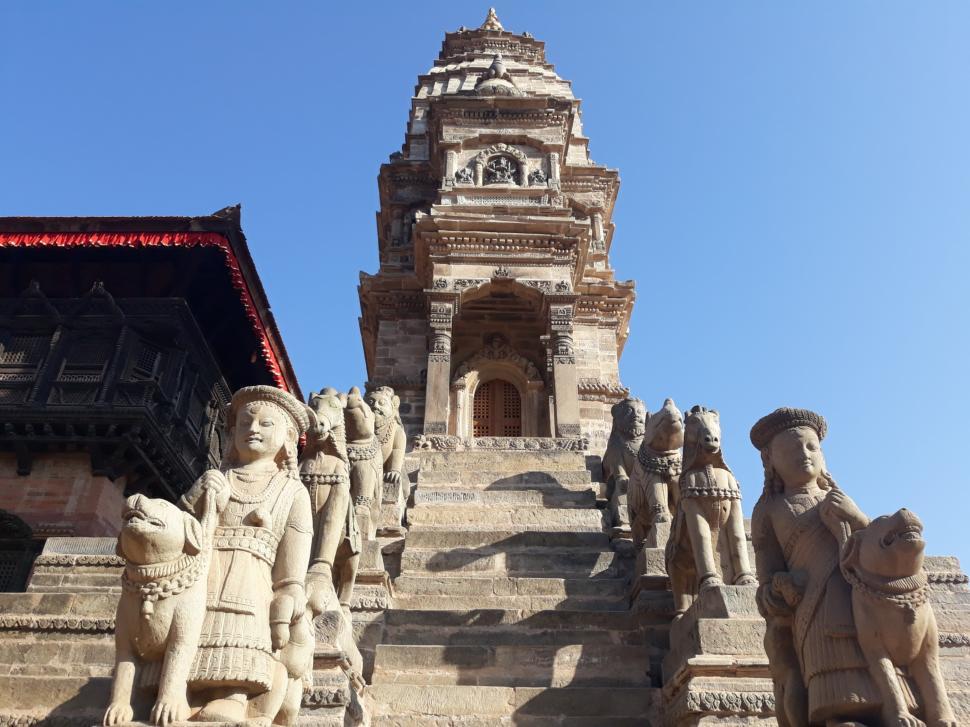
I had come with the other couple of our group, Penny and Dennis Heagy from Maple Ridge. Amazingly they were raised in Castlegar and Dennis’s grandfather had homesteaded on the farm next to my grandfather near Rockglen, Saskatchewan. I knew the name well as my father always visited his dad whenever he came to Castlegar. Their son is married to Kent and Gingers daughter.
The road leading to the square and the square itself had the usual temples, shrines, statues, columns, cisterns and wells. Nyatapola Temple with its five stories is the tallest in the valley at over 30m. Some of the highlights of many of the temples were the large animal statues that guarded the stairways and the carved roof struts with Kama Sutra scenes.
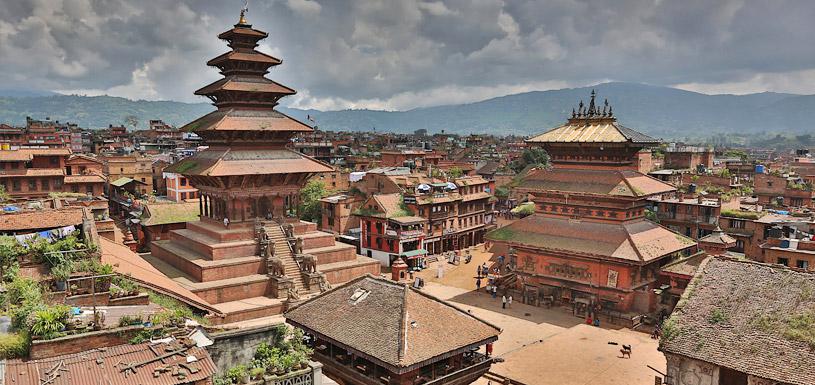
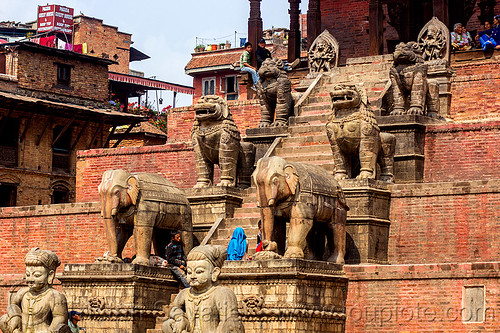
We took a taxi 6km north to Changu Narayan Temple, a beautiful and historic temple perched on a narrow ridge.
The valley was full of terraced rice paddies just ready for harvest. This is my sixth World Heritage site in the valley. After walking through the brick-lined streets of the village, one reaches the two-story pagoda style temple guarded by large stone mythical animal statues. The roof struts were intricately carved Tantric deities. Beautifully decorated metal plate doors surrounded a statue of Vishnu. The views down to the valleys surrounding the ridge were panoramic in the late afternoon light. The taxi ride from Bhaktapur up to Changu and then all the way back to Kathmandu was $20 for the three of us.
The next morning we were up at 4:30 to climb up to the Buddhist temple of Swayambhunath.

Mobbed by rhesus monkeys and soaring above the city on a lofty hilltop, the ‘Monkey Temple’ is a jumble of Hindu and Buddhist icons. After the steep climb up the ancient stone stairway, the stupa is the crowning glory of Kathmandu architecture. On top of the huge white washed dome representing the earth, are the four faces of Buddha staring out in the cardinal directions, and then the 13-tiered beehive-like structure at the top symbolizing the 13 stages that man must pass through to achieve nirvana.
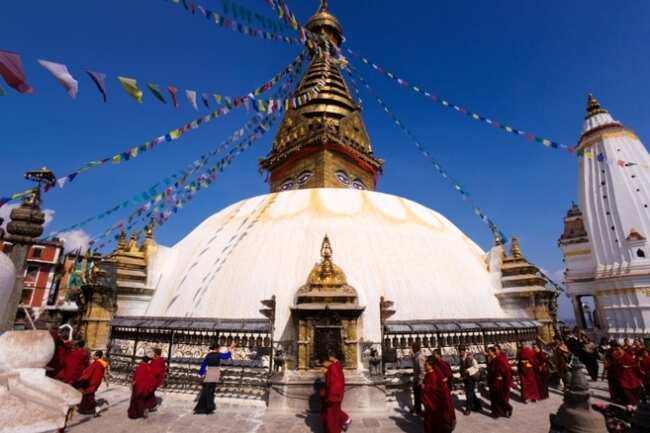
The base of the stupa is ringed by prayer wheels each spun by pilgrims walking clockwise around it. Fluttering above the stupa are thousands of prayer flags with mantras, which are said to be carried to heaven by the winds. The plinths at the base of the stupa and the platform around it are a veritable statue garden.
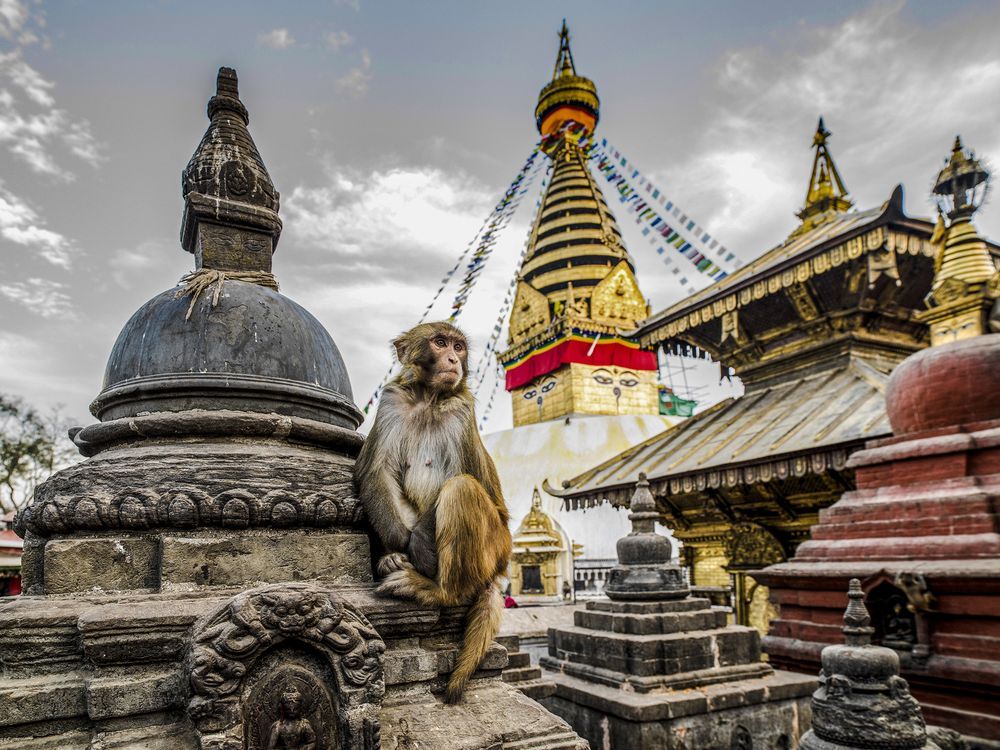

We listened to the morning chant in the monastery and then walked down around the base of the hill past shrines and continuous prayer wheels.
On my way home from my dental appointment, I stopped in at the Garden of Dreams, a quiet oasis amid the din of Kathmandu. Once an aristocrat’s garden, it was renovated 2 years ago. High walls were built to screen out the street noise and an amphitheater was built around a pool. They supply mats and pillows and I was soon asleep. With gardens and reflecting pools set amidst old buildings with columns, it is a welcome sea of tranquility.
POKHARA (pop 200,000, elevation 1000m).
Up at 5:30, we packed, had a quick breakfast and caught 3 cabs to take us to Nima’s place (our Nepalese guide) to load the bus and pick up the 13 porters. All the power lines had to be lifted in his neighbourhood to allow the bus with its roof loaded to get through the streets. It was a long 7-hour drive for the 206km west to Pokhara in the geographic centre of the country. After a steep switchbacking descent, we drove the rest of the way alongside a big river. The barely 2 -lane road was reduced to one lane by all the vehicles broken down in our lane. We competed with pedestrians, cyclists and cows. Porkhara is the gateway town to the Annapurna region and our trek. We stayed in the Lakeside district on the shores of the very picturesque lake. Full of tourists, it is pushing itself to be the adventure capital of Nepal.
Nepal is wedged between the mountain wall of the Himalaya and the steamy jungles of the Indian plain. It is one of the few countries never colonized – the natural barriers of the Himalaya to the north and malarial swamps to the south kept everyone out. Ever since it opened its borders to outsiders in the 1950s, this tiny mountain nation has had a mystical allure to travellers. Climbers come for the high peaks, trekkers come for some of the most challenging hiking anywhere and hippies come for the temple filled towns. Nepal is no longer a kingdom. A decade of Maoist uprising and civil war came to an end with the election of the Communist Party in 2008. They still have not produced a constitution and are apparently an inefficient, corrupt lot. After a huge decline in tourism, peace has returned. The climate has two seasons, the dry season from October to May and the wet (monsoon) season from June to September. The peak tourist season is October and November. With 60+ ethnic and caste groups and up to 100 languages, it is hard to generalize about Nepalese people.
Outside Kathmandu and Pokhara, Nepal is overwhelmingly rural and poor. Farming is the main occupation and 68% of Nepalis live on less than $2/day. Rice is grown up to 2000m; corn, wheat and millet up to 2800m; then barley, buckwheat and potatoes up to 4000m. With a population of 30 million, 4 million reside in India. Simplistically, it is the meeting place of the Indo-Aryan people of India and the Mongoloid peoples of the Himalaya. Religion is a cornerstone of life and Hinduism and Buddhism have mingled wonderfully into a rich syncretic blend. Women have a hard time of it in Nepal with much lower literacy rates and longer harder working hours. It has a national literacy rate of 49% with women at 35%. Abortion was legalized in 2002. $1 Canadian equals 84 Nepalese rupees.
We added 4 young porters, and with Tom, Nima, Vishnu, the cook, and the 5 of us, we bused 2 hours east to Begnas Tal (lake) Bazaar and started our 28 day trek though the area south of the Annapurna range of the Himalaya.
We camped on a peninsula jutting into the lake and the next morning had our first views of Machhapuchhre (6997m, also called Fishtail), the mountain that was to dominate our view for the next 19 days.
It is sacred, has never been climbed (one party got to within 20′ and then descended out of respect to the mountain), and is the only mountain in Nepal that is off-limits. From this perspective, it looked like the Matterhorn but has an equal second peak to the NW. We walked on a ridge high above the big lake for 2 days, descended to a big river, the Madi Nadi, and followed it for 2 days to the town of Parche, 30 minutes walk from our first big destination, Siklis.
Seeing no other tourists and with our guides had never been there before, it was a magical beginning. The local kids spoke no English, were very shy, and content to simply sit for hours and watch our camp. The jeep road built a few years ago was impassable for at least a km before town, so I guess it is still not vehicle accessible.
This Gurung town of 2400 cascades down the mountain ending in the inevitable rice paddies. We walked up to a high overlook above town called Rishing Danda for huge panoramic views of the east section of the Annapurnas just before the cloud moved into to obscure everything. It was a great walk down through herds of goats and cattle to the remote town where we were the only foreigners. All houses are long one-story buildings of brick with a large patio out front where they dry their crops of rice, millet and grain. Corn drying silos are in front of every house. Everything is stone, although metal has replaced the slate roofs. The next day we walked west to a high ridge called Tara Hilltop, where there were two other tour groups camped all there to see the magnificent sunrise. The entire range was visible from Annapurna South to Lamjung.
We then walked 3 days through villages, hundreds of rice paddies, and along rivers to Pitam Deurali, a high pass on the standard trekking route to Annapurna Base Camp (ABC – 4130m). These two weeks are the festival of Dasain, the most important festival of the year. People return home, businesses close, and on day 9, animals are sacrificed. Almost all the towns on the route consist of lodges and did not exist before trekking. Instead of being the only gringos around, we were now surrounded. After another day we arrived at Chhomrong where we would return in five days after completing the one way trip to ABC.
Everyday’s weather is predictable with crystal clear skies in the morning, a spectacular sunrise with the first rays of light hitting the high peaks around 6:30, cloud often appearing by the afternoon and then completely clear skies as soon it is dark. The star displays at night are second to none.

Tom took it easy on us allowing three days to climb up to ABC. With Hilam Chuli (6441m) and Annapurna South (7219m) to the south and west, Fang (7647m) and Annapurna I (8091m) to the NW, Roc Noir 7485m), Fluted Peak (6501m), and Tent Peak (5695m and commonly climbed) to the north and north-east, and Machhapuchre to the southeast, we are completely surrounded.

The common viewing point is a rocky moraine near the lodges and at sunrise it is packed. Many people leave Machhapuchhre Base Camp at 4:30 and hike up to ABC to join the throngs. On the ridge is a monument to Anatoly Bourkreev, of ‘Into Thin Air’ fame, who later died on Annapurna I. Over the ridge is a sheer drop of several hundred feet to the gravel-covered glacier coming off the huge cirque.
After returning to Chhomrong, it was a one day walk down to the Kimrong Khola river then a big climb to the largest and oldest town in the valley, Ghandruk (pop 15,000). Camping at the top of town on a huge lawn with wicker chairs and panoramic views all over was a real treat.

The jeep road to the town is still a kilometre away and it was a joy to walk the old stone streets and stairs. All the houses have slate roofs. We had internet for the second time.
This was our first day off and it was especially welcome for our porters. Having lost 4 porters on day eight, we were down to 13. They are all Tamang people from NE of Kathmandu. None is over 5’7″ or weigh more than 120 lbs, but carry huge loads as we are camping and cooking all our own food. We bought them a complete set of clothing including boots (all the same size!) but they are on their own to find a place to sleep. We call them the Happy Gang as they are constantly chatting and laughing. None speaks a word of English. They play many gambling games, one with 15 pistachio shells that they throw in the air and bet on the way they land. They cook all their own food with dhal baht being the mainstay (rice, dhal, and curried vegetables).
It was then a 2 day walk to Khopra Ridge (elev. 3770), the second day over a narrow, rough trail with steep drop-offs.
This is the closest accessible ridge to the west end of the Annapurnas and gives world-class views of Dailagiri (8150m) to the NW across the end of the Annapurna Circuit and to Annapurna Nigiri (6839m) and Annapurna South. It was a busy place and even had internet. We knew within minutes of Obama’s win much to the joy of all the Americans around. The place must have been crawling with yaks recently as witnessed by all the well eaten grass and dung. Two of us walked up to the high sacred lake with its Hindu shrine at 4700m for a long day.
All four nights spent here were well below freezing and the big stove in the dining room was more than welcome.
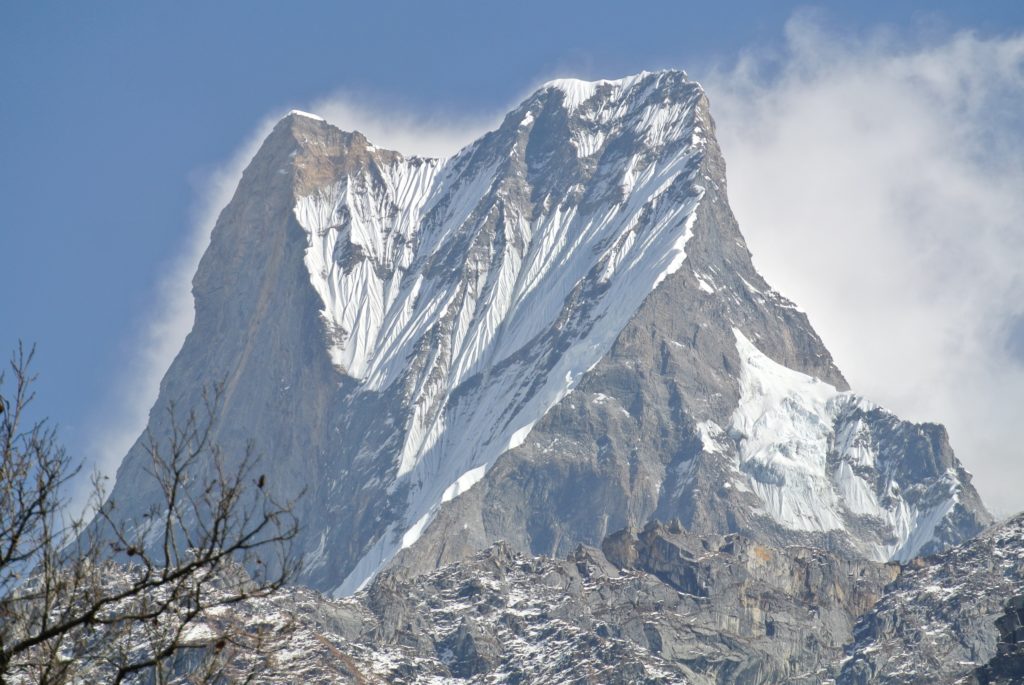

It was then a 3 1/2 day walk out via Gorepani to the road, a bus and a 1 1/2 hour ride back to Pokhara. It was odd having to deal with vehicles and the return to civilization after so many days on the trail.

View of Annapurna II from Poon Hill
The trek was superb. We all felt that we had seen everything in the south Annapurna area, and especially liked the beginning with no other trekkers. Great people, a wonderful staff to look after us, good food, and the best views of the Annapurna from the south, made for a special trip. I initially had some doubts about the 28 day length of the trek but the time flew by. Refer to the following article “A 28 day Trek in Nepal” with details described day-to-day.
We had a big thank you party for the porters and they got their tips. The next morning, everyone else took the bus to Kathmandu. I took a boat out to the Hindu shrine on an island in the lake, continued across to the side of the lake, and walked up to the World Peace Pagoda high above.
A Japanese company whose founder experienced Hiroshima and Nagasaki, is building 100 World Peace Pagodas around the world and this, the 71st, was finished in 1999. It is 115′ high and 355′ in diameter with a different Buddha stature on each side. I had a lovely 1 1/2 hour walk back to Pokhara through a mature sal forest and past a large Tibetan refugee camp. This is the 4th day of Tihar (the Nepalese equivalent of Diwali), the Festival of Lights, a major festival celebrating brothers and sisters. Vehicles are constantly stopped by roving bands of kids extorting money. Cavalcades of motorcycles compete with dancers surrounded by large crowds on every block.
I wanted to visit the Gurka Museum but did not have the time. Part of the British Army, this all Nepali force has a fearsome record of military service with 13 Victoria Crosses. With high pay (for Nepalis), a career pension and possibility of British citizenship, there is a lot of incentive to join and only 1/100 who try out make it. They are so good as Nepal is one of the few places where every environment can be experienced.
The next AM I caught the 8 hour bus heading south into the flat lands and jungle in the south of Nepal called the Terai. I had arranged a 3 day/2 night tour of Chitwan National Park, one of the premier wildlife viewing places in Asia. There are many resorts that all offer the same activities. Our second day involved a great dugout canoe trip down the river with lots of birds and a few crocodiles, a jungle walk, the elephant breeding program, elephant bathing and then the climax, a ride on an elephant. It was possible to see rhinos, peacocks and lots of three species of deer. Sadly, many animals were lost during the Maoist uprising. We then went to a Tharu (the local indigenous people) Cultural Show with great dancing (especially the choreographed fighting stick dances). Before 1950, the Terai was sparsely populated with a few small villages of Tharu who have a natural resistance to malaria. When DDT was introduced in 1954, land hungry peasants from the hills invaded and huge tracts of forest were converted to farmland and most of the animals disappeared. Declared a national park in 1973, 22,000 peasant farmers were removed and the army brought in to control poaching.
On the morning of day 3, we caught the bus (2 days of the 3-day tour were basically the travel days in and out), most traveling to Kathmandu, but I went east to Bhairawa and Lumbini, the birthplace of Buddha in 563 BC. World Heritage-listed, it attracts pilgrims from all over the world. Initially, home to hundreds of monasteries, it was abandoned by 400 AD, and since 1978, Buddhist countries from around the world have constructed extravagant monasteries spread over a huge area. There are wide roads and many reflecting ponds. The Maya Devi Temple sits on the exact site of Buddhas birth. The temple area is reached by a long causeway across a lake that appears to surround the temple like an island. It is a plain low white brick building.

One walks around a platform surrounding what looks like an archaeological dig to see the exact stone he was born on through bulletproof glass.
The whole place is so big that one needs a bicycle to see it all. As I had only a few hours, I hired a bicycle rickshaw and saw a few monasteries and Maya Devi.
It was then a short bus ride back to Bhairawa and a taxi to Sunauli and the Indian Border. Onto the next adventure.
